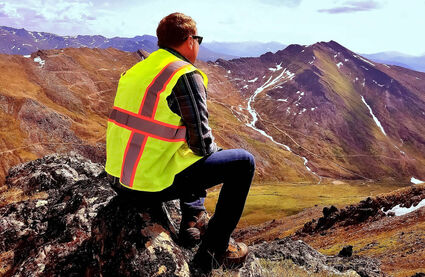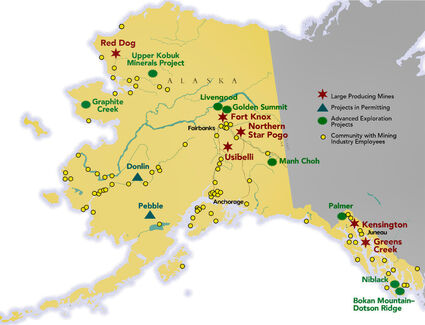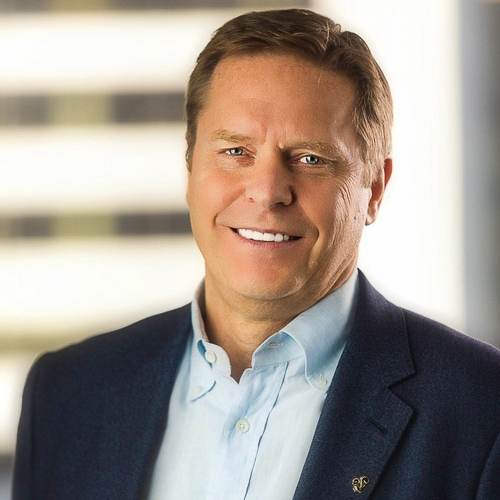Dorothy ... a few ideas on the Great Reset!
Modernizing claim staking and investing in support industries, roads, and sustainable power would strengthen mining in AK North of 60 Mining News - July 8, 2022
Last updated 7/14/2022 at 2:53pm

Bonnie Broman
Rick Van Nieuwenhuyse looks out over the world-class Arctic copper-zinc-gold-silver deposit in the Ambler Mining District in during his tenure as president and CEO of Trilogy Metals.
Last week my good friend and colleague Curt Freeman wrote an article titled: "Is it time to press the reset button?". The article made me laugh and got me thinking – and rather than just falling in line with all the Dorothy's out there and just whine about it or blame COVID, Putin, Biden or the Billionaires club, I decided to proffer a few tangible suggestions that I believe are within reach and importantly - largely within our control, say within the next ten years; we just need to take action.
Here is a short list of specific actions we can take to Reset our business-as-usual approach to mineral exploration and development in Alaska.
1. Change our antiquated system of field staking mining claims and move to an online map staking system supported by blockchain technology to timestamp and document all entries. Most other jurisdictions around the world have transitioned to an online system; there is no reason Alaska doesn't join the 21st century!
We would eliminate the high costs of the initial staking activity by eliminating fixed wing and helicopter transportation, as well as the logistical support necessary to carry out a safe field staking program. We would also eliminate a mountain of obsolete physical paperwork required to file and refile to maintain one's mineral tenure.
By using blockchain technology to timestamp and document all entries, we would have a clean and legally documented record of the complete filing history so that no jiggery-pokery of the record could occur.
Yes, Dorothy, the transition will have some challenges, but our legal system will be able to deal with them. Another advantage to an electronic system would be to dovetail the work commitment filings so that all data collected for assessment work is also captured and accessible to everyone online. Most other mining jurisdictions in the world have made this transition – it is time for Alaska to as well.
2. We need to work smarter, not harder, and to accomplish this we need fewer and better capitalized junior exploration companies. We have way too many junior explorers (more than 2,000 at last count and mostly from Canada and Australia) and for the most part, they are underfunded and highly dependent on last year's drill results and this year's mood of the market to fund their next programs.
And as Curt's article rightly points out, in this post-COVID world they are doing it with only partial results from the previous field season. The way I like to frame the situation is that they are telling a Billion-dollar story with a few bucks in their pocket and their hand constantly out – not a great recipe for success as has been so often demonstrated. What is that saying by Mark Twain: "A mine is a hole in the ground and a liar standing next to it."?
In order to work smarter, you need capital to lay out a plan that is more than a field season in length. Having fewer companies chasing the same pool of capital is a good start.
How to accomplish this is harder to frame. I certainly wouldn't want to see any regulatory oversight mandated, which would result in handing the keys over to the major mining companies, or some sort of government-run exploration program – neither are desired nor likely to be successful.
I suspect the market will take care of the situation itself as it usually does...so maybe on the next cycle a little self-imposed discipline is in order by junior mining executives as well as the investors who fund them!
3. We need Alaskans to step up to the plate and invest in their own State. This can come in many forms. Alaskans and Alaska-based companies can directly support exploration by investing in companies working in Alaska. Doyon has done just this, and I applaud their leadership in this regard.
Alaskans can support permitting efforts and speak up when it comes time to comment on permits. We have consistently done mining well in Alaska and have the track record to prove it!
However, there are other ways Alaskans can invest in our mining and exploration future. As Curt's article points out, we currently have to send all of the rock, soil, stream sediments and drill core samples taken in Alaska to labs in Vancouver, Reno, Mexico and even Perth, Australia, to be analyzed.
The analysis does require high-tech equipment and skilled operators. But it gets worse. Today we only have the capacity to complete a small percentage of the crushing and grinding necessary for sample preparation for all these samples here in state – which means we either have to prep the samples ourselves, which some companies are doing at great expense, or we are sending whole samples to places as far away as Mexico to prep them for the analytical work.
Similarly, we have very few drilling companies based in Alaska, so we are constantly mobbing rigs at great cost from the Lower 48, Canada, or even Australia (true story!).
If this sounds nuts, it's because it is! Surely, we should be able to operate a lab or two in this state with five large-scale operating mines and an exploration spend that has averaged over $100 million per year over the last ten years!
And Dorothy, don't use the excuse that we don't have the expertise, or can't compete because we are too far away from supply chains. If we can afford to ship samples to Mexico, they should be able to ship samples to Alaska.
Anchorage is the fourth busiest air cargo hub in the world! Let's develop the necessary expertise here in state – it just takes capital and the will to execute.
Same goes for drilling. If tax incentives or low-interest loans would help develop these critical support services – let's explore those options. We have some of the best engineers and environmental scientists in the world for arctic conditions, and Doyon is a world leader in oil rig construction/operations and directional drilling.
We need to emulate that success to chemical analysis and diamond core drilling as well.
4. We have talked a lot historically about access to low-cost sustainable power, but it remains one of our greatest impediments to developing as a state.
It is clear that world governments have a plan to transition us to noncarbon-based forms of energy over the next 30 years. There are four types of base load energy that meet those criteria here in Alaska: Hydro, Hydrogen, Geothermal and Nuclear – no Dorothy, wind and solar can't do the job alone.
The good news is we have an abundance of each of these; we just need the will to solidly advance one or all of these.
With reliable, affordable and sustainable power we can do great things in this state – like feed ourselves (I was particularly pleased to hear Governor Dunleavy speak of this at the recent RDC luncheon in Anchorage).
We could also develop state-of-the-art hydrometallurgical facilities (smelters) to produce value-added products from the concentrates of copper, zinc, tin and other metals we mine here – remember, because of our unique geographic position, we are a great transportation hub for the world. If Iceland can develop a green energy (geothermal) aluminum production facility based on transporting bauxite from Brazil, certainly we can emulate that model of success.
5. And finally, another topic we have discussed for years, we need transportation solutions.
We need more roads; we need our major highways to be four-lane roads to accommodate increased traffic; and we need a sustainable solution to transporting materials and people to and from rural Alaska villages or they will not be sustainable.
We know all too well that we need more roads to develop our resources – Ambler Road is but one example, and it has been 40 years in the making. I, too, won't digress and get distracted with all the details there but suffice it to say we know it won't be easy, but it is necessary, and we must work with local leadership in the Kobuk and Koyukuk regions to make this a reality.
Finally, the last pressing transportation issue is in support of rural Alaska and remote exploration programs.
The aircraft that have traditionally supported rural Alaska (DC-6 and DC-9) are not likely to be around in ten years and they are not being replaced by newer versions of similarly capable aircraft; and the Hercules C130 is a wonderful plane, but bloody expensive.
There are new air transport concepts around airships and drones that need to come to fruition and, like the other items on the list, will require sufficient capital and a will to make it happen.
Yes, Dorothy, we live in a world that wants a green energy future and yet vilifies the industry that is needed to accomplish that future – mining. We certainly have our work cut out for us, but as an industry, we have never shied away from a little hard work.
Let's focus on the things that are in our control and Reset how we conduct our mining business here in Alaska.












Reader Comments(0)